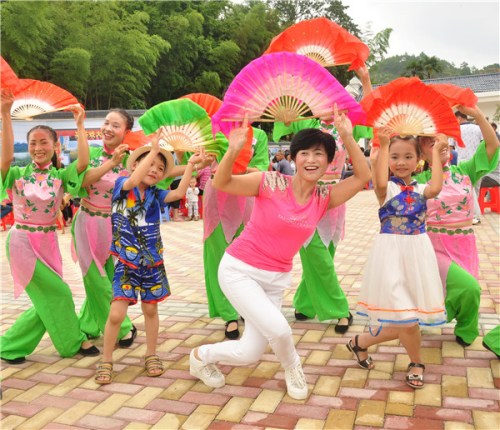
Some women and children practice a dance routine in Anyuan, Jiangxi province. (Photo by Zhong Zhijiang/For China Daily)
In a 450-year-old ancestral temple in a village in East China's Jiangxi province, as dusk falls, a group of women begins what has become a daily ritual. In this hall in which villagers once paid respect to their ancestors, the women are practicing dance routines. Outside there is a relaxed air as adults who have been working in the nearby fields unwind while their children play and dogs scamper about.
At the same time in a spacious downtown square about 200 kilometers away in Changsha, capital of Hunan province, more than 1,000 dancers, mostly in their 50s and 60s, make the moves as music blares out from speakers.
From ancestral temples in villages to stadiums in cities, guangchangwu, or "square dancing", can be seen every day in thousands of China's public spaces. It is encouraged by the central government as grassroots entertainment in the same way that libraries and museums are promoted to build public cultural services.
For a decade, Li Nianqiu, 63, has taught dancing at He Long stadium in Changsha, where hundreds of practice every day. At first his lessons were unpaid, but now he is employed by the local government. He receives free training at college, learning how to organize large dance troupes and the use of big spaces, he says.
"Such dancing in the city began in this stadium. It's really good for society as a whole. For one thing, it means people who could otherwise be wasting their time gambling will go dancing instead. It keeps people fit, too."
Li says he does not need the salary because he owns a factory and several shops.
Those who love to dance-and many of them are retirees-are afforded not only public spaces to pursue their activity, but can also make use of rooms in cultural centers. Liu Hanbing, director of the cultural center at Tianxin district in Changsha, says she is much busier than she was a few years ago because of the number of dance competitions, and the center has to offer free lessons to the public, including calligraphy and music. The target group is retirees or children.
As cultural centers have mushroomed in Hunan, so have museums and libraries. Even at county level there will be two or three museums that serve different functions. The provincial government says Hunan has 109 museums and 129 cultural centers. From 2012 to 2013, it says, it spent about 15.7 billion yuan ($2.53 billion) on building museums, cultural centers and libraries in 122 counties.
"This year the system of building public cultural services has become a national-level matter," says Cui Lei, an officer at the Ministry of Culture. "Besides government funds, we encourage public donations."
In the city of Yulin in the Guangxi Zhuang autonomous region, a cultural center consisting of a basketball field, a library and a stage for such dancing is a must-have for every village. Most were funded by rich villagers, a few donations being as high as 1.6 million yuan, says Lai Chunlin, director of information office of Yunlin.
Funding cultural institutions has become a way of flaunting wealth, he says. This matter of pride transcends individuals, with villages-many of whose inhabitants often have the same surname-vying with one another to be connected to the biggest cultural centers, dance troupes and most successful sports teams.
As night falls, Yulin is transformed into a big stage. Whether it is in some tiny open space or an expansive square, until 10 pm local opera shows, music performances and square dancing by troupes of elderly women will hold sway.
As long as, say, 20 square meters or so of space is available, there will be public performances, and most of them will be dancing, Lai says.
Of course, not every place in China is as rich as Yulin, and that is when government funding comes into play.
Anyuan, in Jiangxi province, is a case in point. The authorities of this underdeveloped county say it has annual revenues of about 1.3 billion yuan, with almost half the amount being spent on cultural infrastructure in the past few years. The result is an attractive theater and a spacious stadium that are the fanciest buildings in the county. The movements in the dancing here imitate workers picking tea leaves.
In fact, this folk dance is so deeply rooted in local culture that most local people seem to be able to dance, including many government officials who practice early in the morning or in the evening after dinner.
Not only does almost every village have a stage for square dancing, but the county is also building swish museums and libraries that can hold their own with any others from elsewhere in China.
"People are spending a lot of their time dancing and engaging in cultural activities, so there is less gambling and personal feuds," says Pan Shaoning, a local government officer. "At the same time, the aged and the retired have things to do."
















































